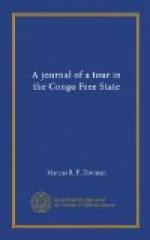Between the belts of forests the country is covered with coarse grass, six or seven feet high, dotted here and there with palms. No vestige of animal life is visible and only a few natives who are engaged on the railway. These inhabit villages near at hand, formed of huts built of reeds or bamboo and thatched with grass. The men wear a loin cloth only, but the women are wrapped in a plain piece of richly coloured cloth which reaches from the neck to the ankle leaving the arms and feet bare. This is evidently a simple length of stuff some three or four feet wide and, to the masculine eye at least, its method of support remains a mystery, for no trace of button, hook or pin is apparent. Their faces are of the negroid type with broad noses and thick lips and the figures of the women approach the shape of an S reversed thus [backwards S] and are similar to those which our American cousins have so largely developed. The men are as a rule thin and tall with very long legs and all appear to have only small arches to their feet. On the lower Congo however, there are many foreigners and several other types are visible. As far as one can judge by the railway cuttings, the soil on the plateau is coarse sand and gravel containing iron and quite unsuitable for agricultural purposes under such a hot sun. The air however, as we approach Tumba, about 2000 feet above sea level, is dry and fresh and at 4 p.m. we halt there for the night.
We are met by Commandant Delhaz, the Commissaire of the Cataracts District, who kindly places a bungalow at our disposal for the night and shows us round the settlement. There is only a small native village here, but large barracks consisting of lines of clean, clay huts constructed by the soldiers. Tumba is indeed an important military centre and here again the appearance of the troops is very fine as they march to the strains of the band which renders snatches from Faust, Carmen and other well known airs with a few native variations. A farm has been established in the neighbourhood to feed the garrison and an automobile road is in course of construction.
Next morning, we dress by candle light and make a hasty breakfast, in the midst of which, at 6 a.m., reveille sounds and the troops assemble in the square in front of the Residency. Half an hour afterwards, the train starts, and having perched ourselves on the summits of the seats, we soon reach Sonna Gongo the half-way house for travellers of the future. Here is a depot for locomotives and carriages and wooden hotels are being constructed to accommodate travellers who, after August, will stop here for the night instead of at Tumba.




